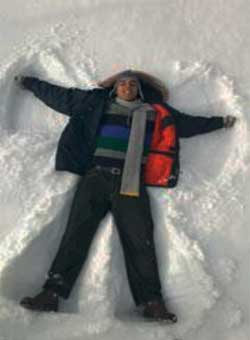
08 Mar Tips to Keep Feet Warm and Cozy All Winter Long
Whether you’re slogging through deep snow and sub-zero temperatures in the north, or contending with dampness, chill, and muddy conditions in the south, it’s important to take care of your feet all winter long. You’ll want them to be healthy and ready for action when spring finally arrives.
Most Americans will have walked 75,000 miles by the time they turn 50. Is it little wonder, then, that APMA’s 2010 foot health survey found that foot pain affects the daily activities—walking, exercising, or standing for long periods of time—of a majority of Americans?
“Each season presents unique challenges to foot health,” said Matthew Garoufalis, DPM, a podiatrist and APMA past-president. “Surveys and research tell us that foot health is intrinsic to overall health, so protecting feet all year long is vital to our overall well-being.”
APMA offers some advice for keeping feet healthy in common winter scenario:
- Winter is skiing and snowboarding season, activities enjoyed by nearly 10 million Americans, according to the National Ski Areas Association. Never ski or snowboard in footwear other than ski boots specifically designed for that purpose. Make sure your boots fit properly; you should be able to wiggle your toes, but the boots should immobilize the heel, instep, and ball of your foot. You can use orthotics (support devices that go inside shoes) to help control the foot’s movement inside ski boots or ice skates.
- Committed runners don’t need to let the cold stop them. A variety of warm, light-weight, moisture-wicking active wear available at most running or sporting goods stores helps ensure runners stay warm and dry in bitter temperatures. However, some runners may compensate for icy conditions by altering how their foot strikes the ground. Instead of changing your footstrike pattern, shorten your stride to help maintain stability. And remember, it’s more important than ever to stretch before you begin your run. Cold weather can make you less flexible in winter than you are in summer, so it’s important to warm muscles up before running.
- Boots are must-have footwear in winter climates, especially when dealing with winter precipitation. Between the waterproof material of the boots themselves and the warm socks you wear to keep toes toasty, you may find your feet sweat a lot. Damp, sweaty feet can chill more easily and are more prone to bacterial infections. To keep feet clean and dry, consider using foot powder inside socks and incorporating extra foot baths into your foot care regimen this winter.
- Be size smart. It may be tempting to buy pricey specialty footwear (like winter boots or ski boots) for kids in a slightly larger size, thinking they’ll be able to get two seasons of wear out of them. But unlike coats that kids can grow into, footwear needs to fit properly right away. Properly fitted skates and boots can help prevent blisters, chafing, and ankle or foot injuries. Likewise, if socks are too small, they can force toes to bunch together, and that friction can cause painful blisters or corns.
Finally—and although this one seems like it should go without saying, it bears spelling out—don’t try to tip-toe through winter snow, ice, and temperatures in summer-appropriate footwear. “More than one news show across the country aired images of people in sneakers, sandals, and even flip-flops during the severe cold snap that hit the country in early January,” Dr. Garoufalis said. “Exposing feet to extreme temperatures means risking frostbite and injury. Choose winter footwear that will keep your feet warm, dry, and well-supported.”
If you have questions or concerns regarding your foot health, please don’t hesitate to call our office to schedule an appointment with one of our podiatrists. 973-467-9011.
Advanced Performance and Rehabilitation Center
532 Old Short Hills Road – Short Hills
111 Madison Avenue, suite 408 – Morristown
Source: American Podiatric Medical Association / apma.org

